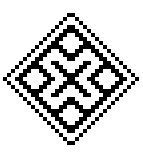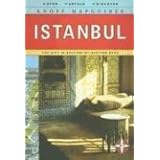Copyright Photographs and Text by Coşkun Yanar
Rug (Zili) Bag, Yenice town, Çanakkale, 42×36
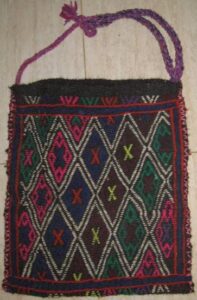
| Name of the Fabric | Rug (Zili) Bag |
| Where It Touches | Yenice Region |
| quality | 42×36 |
| size | 40×46 |
| Material Used | Double layer wool warp, single layer wool weft |
| Weaving Technique | Plain Weave, bell |
| Composition | It is decorated with the repetition of the velcro motif. In order to become a woven bag, it is folded and joined at the edges and the edges are knitted with colored pattern threads. In order to become a woven bag, it is folded and joined at the edges and the edges are knitted with colored pattern threads. |
| motifs | Pitrak |
| warp | double bristle |
| Scarf | double bristle |
| Colors Used | Red, white, green, dark blue, pink, brown, black |
velcro motif
Pıtrak Motif: It is inspired by the Pıtrak plant. It was used as an amulet against the evil eye. It is a symbol of abundance, protecting from all kinds of evil eye and evil eye. It was frequently used in flour sacks, tandoori covers, and bread covers to make them fertile.
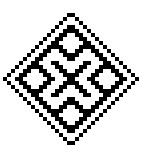

by Coşkun Yanar, 2013
Rug (Zili) Bag, Yenice town, Çanakkale. 42×144

| Name of the Fabric | Rug (Zili) Bag |
| Where It Touches | Yenice Region |
| quality | 42×144 |
| size | 41×46 |
| Material Used | Double layer wool warp, single layer wool weft |
| Weaving Technique | Plain Weave, bell |
| Composition | At the beginning and at the end of the weaving, a band was formed from seven bala motifs, and the border was decorated with an eye motif. On the interior floor; The star motif in the middle and the velcro motif are placed inside, the inner eye motif is placed on the corners of the star motif, and the seven bala motifs are placed on the lower and upper parts. The back of the fabric is woven into bands with colored threads. In order to become a woven bag, it is folded and joined at the edges and the edges are knitted with colored pattern threads. It is tied to the edges by making tassels from pattern threads. |
| motifs | Star, eyeball, seven honeys, flutter |
| warp | Double wool warp |
| Scarf | Single layer wool scarf |
| Colors Used | Red, white, green, dark blue, pink, brown, black |
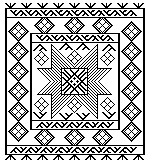

star, intraocular, seven
honey, velcro motifs
seven honey motifs
Star: Like the moon and the sun, the stars also occupy a large place in folk beliefs. The reason for these beliefs coincides with the periods when celestial beings were blessed as gods or goddesses. The beliefs of the Anatolian peoples establish a fateful connection between the stars and people. This connection exists in pre-Islamic and post-Islamic Anatolian religions and in the beliefs of all neighboring nations.
Intraocular: Symbols of abundance.
Pıtrak Motif: It is inspired by the Pıtrak plant. It was used as an amulet against the evil eye. It is a symbol of abundance, protecting from all kinds of evil eye and evil eye. It was frequently used in flour sacks, tandoori covers, and bread covers to make them fertile.
Seven Balas:It is one of the names given to the motifs used in border arrangements in the Çanakkale region. It is a local name.
by Coşkun Yanar
Rug (Zili) Bag, Yenice town, Çanakkale, 44×36
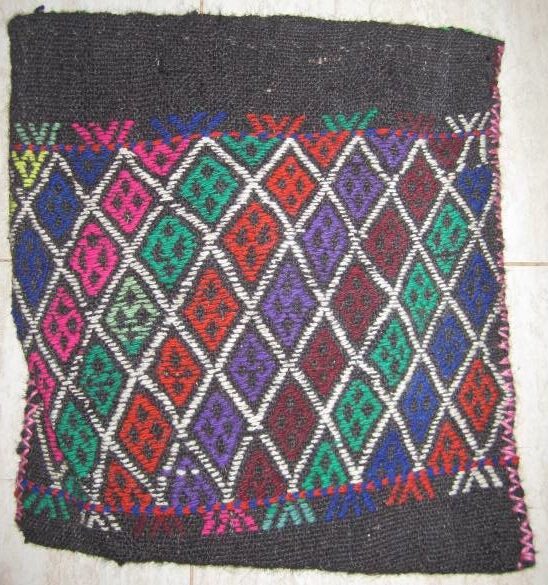
| Name of the Fabric | Rug (Zili) Bag |
| Where It Touches | Yenice Region |
| quality | 44×36 |
| size | 40×44 |
| Material Used | Double layer wool warp, single layer wool weft |
| Weaving Technique | Plain Weave, bell |
| Composition | It is decorated with the repetition of the velcro motif. In order to become a woven bag, it is folded and joined at the edges and the edges are knitted with colored pattern threads. |
| motifs | intraocular |
| warp | double bristle |
| Scarf | double bristle |
| Colors Used | Red, white, green, dark blue, pink, brown, black |
Pitrak Motif:

intraocular
Pıtrak Motif: It is inspired by the Pıtrak plant. It was used as an amulet against the evil eye. It is a symbol of abundance, protecting from all kinds of evil eye and evil eye. It was frequently used in flour sacks, tandoori covers, and bread covers to make them fertile.
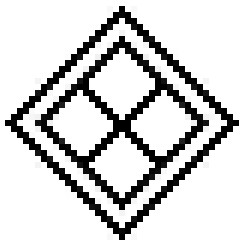
by Coşkun Yanar, 2013
Rug (Zili) Bag, Yenice town, Çanakkale, 44 x 144
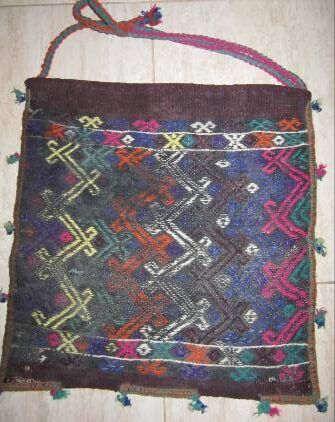
| Name of the Fabric | Rug (Zili) Bag |
| Where It Touches | Yenice Region |
| quality | 44 x 144 |
| size | 44x44cm |
| Material Used | Double layer wool warp, single layer wool weft |
| Weaving Technique | Plain Weave, bell |
| Composition | The Elibelinde motif is placed in bands with the transverse bell weaving technique. A band is formed at the beginning and end of the weaving, and the interior is decorated by taking a section from the motifs of the weaving. The back of the fabric is woven into bands with colored threads. In order to become a woven bag, it is folded and joined at the edges and the edges are knitted with colored pattern threads. It is tied to the mouth of the bag by knitting a tie from the pattern threads. It is tied to the edges by making tassels from pattern threads. |
| motifs | man, hand on waist |
| warp | Double wool warp |
| Scarf | Single layer wool scarf |
| Colors Used | Red, white, green, blue, purple, pink, yellow, brown, black |
Man, hand on waist motif : This motif is the symbol of femininity and fertility. It also symbolizes abundance, fertility, luck, fortune and happiness. It was widely used in weavings in Anatolia. Many mountains in Anatolia have been given the names of various mother goddesses. The mountain known as Mount Ida in mythology was named Mount Ida. Mount Ida in mythology is the place where the Sarıkız Legend, which tells about an innocent and pure love, takes place. Ida or Kaz Mountain is the mountain where Paris, the son of the Trojan King, was a shepherd, the Trojan Wars took place after the Spartan King kidnapped his wife Helena, and Paris was killed after the destruction of Troy.
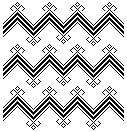
by Coşkun Yanar
Rug (Zili) Bag, Yenice town, Çanakkale
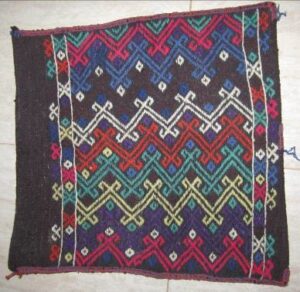
| Name of the Fabric | Rug (Zili) Bag |
| Where It Touches | Yenice Region |
| quality | 44×140 |
| size | 46 x 49 cm |
| Material Used | Double layer wool warp, single layer wool weft |
| Weaving Technique | Plain Weave, bell |
| Composition | The Elibelinde motif is placed in bands with the transverse bell weaving technique. A band is formed at the beginning and end of the weaving, and the interior is decorated by taking a section from the motifs of the weaving. The back of the fabric is woven into bands with colored threads. In order to become a woven bag, it is folded and joined at the edges and the edges are knitted with colored pattern threads. |
| motifs | man, hand on waist |
| warp | double layer wool |
| Scarf | Single layer wool scarf |
| Colors Used | Red, white, green, blue, purple, pink, yellow, brown, black |
Man, hand on waist motif : This motif is the symbol of femininity and fertility. It also symbolizes abundance, fertility, luck, fortune and happiness. It was widely used in weavings in Anatolia. Many mountains in Anatolia have been given the names of various mother goddesses. The mountain known as Mount Ida in mythology was named Mount Ida. Mount Ida in mythology is the place where the Sarıkız Legend, which tells about an innocent and pure love, takes place. Ida or Kaz Mountain is the mountain where Paris, the son of the Trojan King, was a shepherd, the Trojan Wars took place after the Spartan King kidnapped his wife Helena, and Paris was killed after the destruction of Troy.

by Coşkun Yanar, 2013
Carpet Bag, Weawing, Yenice Town, Çanakkale
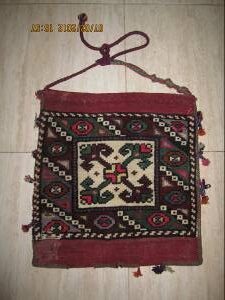
| Carpet Name | Carpet Bag | |
| Where It Touches | Yenice region | |
| quality | 22×26 | |
| size | 42x32cm | |
| kilim | Beginning | 7 cm |
| Mouth | 6 cm | |
| Material Used | Wool warp, wool weft, wool loop | |
| Weaving Technique | pile weaving | |
| Composition | Carpet is bag woven. The outer edge of the border is surrounded by a gooseneck motif, and the inner edge is surrounded by a rat-tooth motif, and the inside of the border is decorated with a five-stone and baklava motif. The interior floor is decorated with a ¼ symmetry arrangement of the pomegranate flower motif. The back of the bag is rug woven. The colored threads used in weaving are attached to the weaving by forming a bond. Tassels are attached to the edges from colored pattern threads. | |
| motifs | Rattooth, gooseneck, pentacle, baklava, pomegranate flower | |
| warp | Double wool warp | |
| Scarf | Single layer wool scarf | |
| Knot Technique | Turkish knot ( Gordes knot ) | |
| Colors Used | Green, orange, pink, purple, brown, black, blue, white | |
| Pile Height | 5mm | |
Five stones, lozenge motif
flower motif
Gooseneck motif

Rattooth motif
![]()
Pomegranate Flower: It is narrated that the pomegranate flower and its fruit are the fruit of Paradise and express holiness in Anatolia. It is seen that it symbolizes fertility and eternity, reproduction and reproduction in Turks.
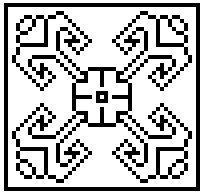
Baklava: They are motifs consisting of geometric shapes resembling baklava slices.

Border motifs: Some motifs used on borders in Çanakkale region; five stone, rat tooth, goose neck, green water, seven honey, etc. The motifs used in the borders are named for their similarity to some objects in nature. Gooseneck, rattooth, waterway, etc. many motifs are used on borders in weaving.
Waterway, green water: Water is the symbol of life in Anatolia. It is the symbol of rebirth, continuity of life, fertility, nobility, wisdom, purity and virtue. It is the opposite of fire.
Five stones: The number five is thought to be good for the bad eye by establishing a connection with the fingers of the hand. It has been tried to give a certain meaning to these motifs by forming the motifs created with the shapes in nature with numbers such as three, five and seven.
Seven Bala: It is one of the names given to the motifs used in border arrangements in the Çanakkale region. It is a local name.
by Coşkun Yanar, 2013
Carpet Saddlebag, Yenice town, Çanakkale
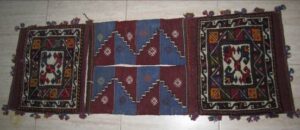
| Carpet Name | Carpet Saddlebag | |||
| Where It Touches | Yenice region | |||
| quality | 22×26 | |||
| size | saddlebag size | 135 cm | one. | 45x34cm |
| 2nd. | 45x34cm | |||
| kilim | 4 cm | |||
| Material Used | Wool warp, wool weft, wool loop | |||
| Weaving Technique | pile weaving | |||
| Composition | The carpet weaving part has two borders. These borders are surrounded by a gooseneck motif on the outside and a rat-tooth motif on the inside, the outer border is decorated with green water and the inner border is decorated with amulet motifs. The interior floor is decorated with a ¼ symmetry arrangement of the pomegranate flower motif. The back of the saddlebag is rug woven. The middle part is woven separately and decorated with the cicim weaving technique of the velcro motif. In the middle part kilim weaving, decoration was created with the buttonhole kilim technique. The back of the fabric is woven into bands with colored threads. Tassels are attached to the edges from colored pattern threads. | |||
| motifs | Amulet, rattooth, gooseneck, sturgeon, green water, pomegranate flower | |||
| warp | Double wool warp | |||
| Scarf | Single layer wool scarf | |||
| Knot Technique | Turkish knot ( Gordes knot ) | |||
| Colors Used | Green, brown, purple, orange, pink, yellow, black, white | |||
| Pile Height | 5mm | |||
Pomegranate flower
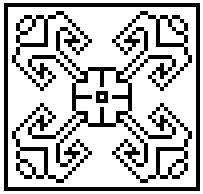
Green water
![]()
Gooseneck motif

Rat tooth
![]()
amulet motif
![]()
Pıtrak motif
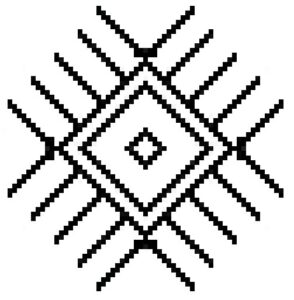
Pıtrak Motif: It is inspired by the Pıtrak plant. It was used as an amulet against the evil eye. It is a symbol of abundance, protecting from all kinds of evil eye and evil eye. It was frequently used in flour sacks, tandoori covers, and bread covers to make them fertile.
Pomegranate Flower: It is narrated that the pomegranate flower and its fruit are the fruit of Paradise and express holiness in Anatolia. It is seen that it symbolizes fertility and eternity, reproduction and reproduction in Turks.
Waterway, green water: Water is the symbol of life in Anatolia. It is the symbol of rebirth, continuity of life, fertility, nobility, wisdom, purity and virtue. It is the opposite of fire.
by Coşkun Yanar, 2013
Carpet Saddlebag, Yenice town, ÇanakkaleRug (Zili) Bag, Yenice Town, Çanakkale, 42 warps x 152 wefts

| Name of the Fabric | Rug (Zili) Bag |
| Where It Touches | Yenice Region |
| quality | 42 warps x 152 wefts |
| size | 39×46 |
| Material Used | Double layer wool warp, single layer wool weft |
| Weaving Technique | Plain Weave, bell |
| Composition | The Elibelinde motif is placed in bands with the transverse bell weaving technique. A band is formed at the beginning and end of the weaving, and the interior is decorated by taking a section from the motifs of the weaving. The back of the fabric is woven into bands with colored threads. In order to become a woven bag, it is folded and joined at the edges and the edges are knitted with colored pattern threads. It is tied to the mouth of the bag by knitting a tie from the pattern threads. |
| motifs | man, hand on waist |
| warp | Wool. |
| Scarf | Wool |
| Colors Used | Red, white, green, blue, pink, purple, yellow, brown, black |
Man, hand on waist motif : This motif is the symbol of femininity and fertility. It also symbolizes abundance, fertility, luck, fortune and happiness. It was widely used in weavings in Anatolia. Many mountains in Anatolia have been given the names of various mother goddesses. The mountain known as Mount Ida in mythology was named Mount Ida. Mount Ida in mythology is the place where the Sarıkız Legend, which tells about an innocent and pure love, takes place. Ida or Kaz Mountain is the mountain where Paris, the son of the Trojan King, was a shepherd, the Trojan Wars took place after the Spartan King kidnapped his wife Helena, and Paris was killed after the destruction of Troy.
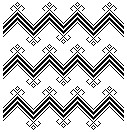
Rug (Zili) Bag, Yenice town Çanakkale

| Name of the Fabric | Rug (Zili) Bag |
| Where It Touches | Yenice Region |
| Material Used | Double layer wool warp, single layer wool weft |
| Weaving Technique | Plain Weave, bell |
| Composition | At the beginning and at the end of the weaving, a band was formed from seven bala motifs, and the border was decorated with an eye motif. On the interior floor; The star motif in the middle and the velcro motif are placed inside, it is decorated with an intraocular motif at the corners of the star motif, seven bala motifs on the lower and upper parts, and a columnar placement of the intraocular motif on the edges. The back of the fabric is woven into bands with colored threads. In order to become a woven bag, it is folded and joined at the edges and the edges are knitted with colored pattern threads. It is tied to the mouth of the bag by knitting a tie from the pattern threads. |
| motifs | Star, eyeball, seven honeys, flutter |
| warp | Double wool warp |
| Scarf | Single layer wool scarf |
| Colors Used | Red, white, green, dark blue, pink, brown, black |
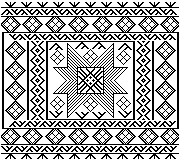
Star, eye, seven honeys,
hook and loop motifs
Star: Like the moon and the sun, the stars also occupy a large place in folk beliefs. The reason for these beliefs coincides with the periods when celestial beings were blessed as gods or goddesses. The beliefs of the Anatolian peoples establish a fateful connection between the stars and people. This connection exists in pre-Islamic and post-Islamic Anatolian religions and in the beliefs of all neighboring nations.
Intraocular: Symbols of abundance.
Seven Bala: It is one of the names given to the motifs used in border arrangements in the Çanakkale region. It is a local name.
Pıtrak Motif: It is inspired by the Pıtrak plant. It was used as an amulet against the evil eye. It is a symbol of abundance, protecting from all kinds of evil eye and evil eye. It was frequently used in flour sacks, tandoori covers, and bread covers to make them fertile.
Rug (Zili) Bag, Yenice town, Çanakkale
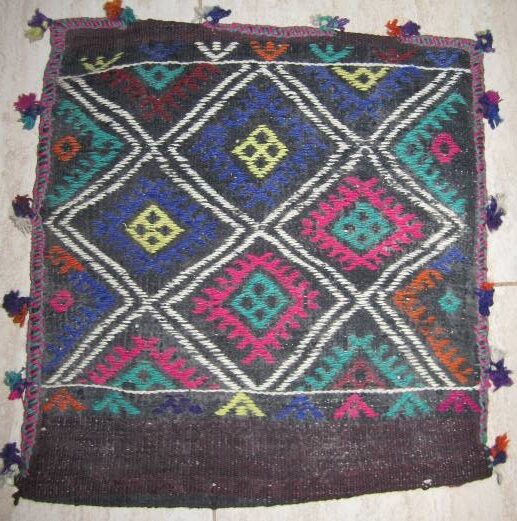
| Name of the Fabric | Rug (Zili) Bag |
| Where It Touches | Yenice Region |
| quality | 38 x 156 |
| size | 38×41 |
| Material Used | Double layer wool warp, single layer wool weft |
| Weaving Technique | Plain Weave, bell |
| Composition | It is decorated with the repetition of the velcro motif. In order to become a woven bag, it is folded and joined at the edges and the edges are knitted with colored pattern threads. The back of the fabric is woven into bands with colored threads. It is tied to the mouth of the bag by knitting a tie from the pattern threads. |
| motifs | Pitrak |
| warp | Double wool warp |
| Scarf | Single layer wool scarf |
| Colors Used | Red, white, green, dark blue, pink, brown, black |
velcro motif
Pıtrak Motif: It is inspired by the Pıtrak plant. It was used as an amulet against the evil eye. It is a symbol of abundance, protecting from all kinds of evil eye and evil eye. It was frequently used in flour sacks, tandoori covers, and bread covers to make them fertile.

Rug (Zili) Bag, Yenice town, Çanakkale, 48×34
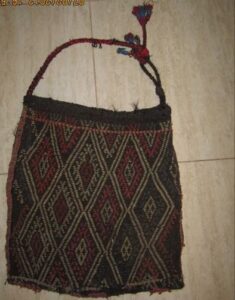
| Name of the Fabric | Rug (Zili) Bag |
| Where It Touches | Yenice Region |
| quality | 48×34 |
| size | 42×44 |
| Material Used | Double layer wool warp, single layer wool weft |
| Weaving Technique | Plain Weave, bell |
| Composition | It is decorated with the repetition of the velcro motif. In order to become a woven bag, it is folded and joined at the edges and the edges are knitted with colored pattern threads. It is tied to the mouth of the bag by knitting a tie from the pattern threads. It is tied to the mouth of the bag by knitting a tie from the pattern threads. In order to become a woven bag, it is folded and joined at the edges and the edges are knitted with colored pattern threads. |
| motifs | Pitrak |
| warp | double bristle |
| Scarf | double bristle |
| Colors Used | Red, white, green, dark blue, purple, pink, brown, black |
Pıtrak Motif: It is inspired by the Pıtrak plant. It was used as an amulet against the evil eye. It is a symbol of abundance, protecting from all kinds of evil eye and evil eye. It was frequently used in flour sacks, tandoori covers, and bread covers to make them fertile.
